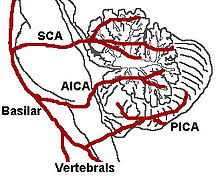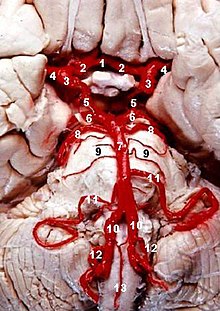Wallenberg syndrome
| Classification according to ICD-10 | |
|---|---|
| G46.3 |
Brainstem Syndrome Wallenberg Syndrome |
| ICD-10 online (WHO version 2019) | |
The Wallenberg syndrome (syn .: Viesseaux-Wallenberg and Wallenberg-Foix syndrome or also dorsolateral medulla oblongata or arteria-cerebellaris-inferior-posterior syndrome) is caused by an occlusion of the arteria cerebelli inferior posterior (PICA) or the arteria vertebralis . The result is an infarction of the dorsolateral medulla oblongata , which is part of the brain stem . It is a rare form of stroke . The symptoms are varied according to the neurological structures affected.

Cause / pathology
There is an occlusion or severe constriction in the area of the posterior inferior cerebellar artery ( arteria cerebelli inferior posterior ) or the arteria vertebralis and its branches, which supply parts of the elongated medulla ( medulla oblongata ). This leads to an infarction on the lateral part of the medulla oblongata, with the typical failure patterns. The most common artery affected is the vertebral artery.
Symptoms
Typical equilateral occurring (ipsilateral) characters, such as an attenuated are corneal reflex , sensory disturbance of the face, Horner syndrome , vocal cord paralysis, soft palate paresis and Hemi ataxia . On the contralateral side (on the opposite side) there may be a dissociated sensibility disorder (disturbance of the temperature and pain sensation while the sensation of touch is preserved) on the body (not on the face). A tendency to fall to the diseased side and ipsilateral nystagmus are also typical .
Location of damage
Damage to the trigeminal spinal nucleus causes the absence of pain on the ipsilateral side of the face, as does a weakened or absent corneal reflex. If the spinothalamic tract is damaged, there is a lack of pain and temperature perception on the side of the body opposite the infarct. The damage in the cerebellum and / or in the lower cerebellar limb (Pedunculus cerebellaris inferior) leads to ataxia . The damage in the hypothalamospinal fibers disrupts sympathetic signal transmission and can lead to Horner syndrome. Nystagmus and dizziness through the involvement of the region of the nucleus Deiter ( lateral vestibular nucleus caused) and other vestibular nuclei. A palatal myoclonus may possibly of malfunctioning of the central tegmental tract occur.

| Location of damage | effect |
| Nucleus vestibular inferior | Vertigo (dizziness) on the side of the damage, diplopia (double vision ), spontaneous nystagmus (eye tremors ) on the opposite side of the damage, vomiting |
| Nucleus ambiguus (effect on the vagus N. X and glossopharyngeus N. IX ) | Dysphagia (swallowing disorders), hoarseness , weakened gag reflex , backdrop phenomenon (deviation of the uvula during phonation to the healthy side) |
| Nucleus tractus spinalis nervi trigemini N.V | ipsilateral sensitivity disturbance (loss of pain and temperature sensation) in the face |
| Nucleus tractus solitarii (parts of the N. VII, N. IX and N. X) | also weakened gag reflex and weakened nausea |
| Nucleus dorsalis nervi vagi | s. o. - Nucleus ambiguus |
| Formatio reticularis | |
| Pedunculus cerebellaris inferior | Ipsilateral cerebellar signs including trunk and gait ataxia (gait disorders) |
| Central tegmental tract | Palatal myoclonus |
| Lateral spinothalamic tract | contralateral dissociated sensory disorder (disturbance of the sensation of temperature and pain while the sensation of touch is preserved) on the body |
| central sympathetic tract | ipsilateral Horner syndrome (triad: constricted pupil, drooping of the upper eyelid, apparently sunken eyeball) with hemianhidrosis (unilateral disorder of sweating) |
therapy
Treatment of Wallenberg syndrome is only possible symptomatically. A feeding tube may be necessary if swallowing is difficult. Speech and swallowing therapy may be needed. In some cases, medication can help reduce or eliminate the pain. The anti- epileptic gabapentin could, in individual cases, be a suitable drug for patients with chronic pain. The small size of the affected PICA is not suitable for surgical recanalization.
In the long term, prophylaxis against recurrent stroke is necessary. Treatment of the risk factors is crucial. Patients are often put on an ASA treatment regimen on a permanent basis to minimize the risk of another stroke. Under certain circumstances (e.g. atrial fibrillation ), long-term treatment with anticoagulants (anticoagulants) also occurs. Other drugs may be useful to suppress high blood pressure and other risk factors associated with stroke. A change in lifestyle improves the prognosis (as in primary prophylaxis).
forecast
The outlook for someone with Wallenberg syndrome depends on the size and location of the area damaged by the stroke. In some people, recanalization causes symptoms to decrease within weeks or months. However, the majority can still have significant neurological disabilities years later.
history
The syndrome was first mentioned in 1808 by Gaspard Vieusseux. The Wallenberg syndrome is named after the German neurologist Adolf Wallenberg , who first described the syndrome clinically in 1895 and was able to confirm it by means of an autopsy in 1901.
literature
- Norbert Rösler, Michael Hüll, Joachim Bauer : Nervous system. In: Michael Pfreundschuh, Jürgen Schölmerich (Hrsg.): Pathophysiology, Pathobiochemistry. 2nd Edition. Munich 2004, ISBN 3-437-42001-1 , p. 379.
- Wolfgang H. Oertel et al .: Nervous System. In: Walter Siegenthaler , Hubert E. Blum (Ed.): Clinical Pathophysiology , 9th completely new. Edition. Stuttgart / New York 2006, ISBN 3-13-449609-7 , p. 1049.
Individual evidence
- ↑ a b H.-C. Hopf: diseases of the cranial nerves. Georg Thieme Verlag, 2006, ISBN 3-13-140111-7 , (online)
- ↑ neuroophthalmology.ca ( Memento of the original from September 14, 2008 in the Internet Archive ) Info: The archive link was inserted automatically and has not yet been checked. Please check the original and archive link according to the instructions and then remove this notice.
- ↑ a b ninds.nih.gov ( memento of the original from March 18, 2014 on WebCite ) Info: The archive link was automatically inserted and not yet checked. Please check the original and archive link according to the instructions and then remove this notice.
- ↑ awmf.org ( Memento of the original from April 17, 2012 in the Internet Archive ) Info: The archive link was inserted automatically and has not yet been checked. Please check the original and archive link according to the instructions and then remove this notice.
- ↑ whonamedit.com
- ↑ Adolf Wallenberg: Acute Bulbäraffektion (embolism of the art. Cerebellar. Post. Inf. Sinistra?) In: Arch. Psychiat. Nerve crisis 27, 1895.
- ^ Whonamedit.com: Wallenberg's syndrome. (online) ; last accessed on 6 Aug 2011.

